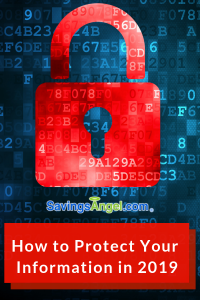How to Protect Your Information in 2019
This post may contain affiliate links or links to sponsors of the SavingsAngel.com
The sophistication of how criminals can get their hands – or rather their computers – onto your family’s information is always evolving. That’s why it’s important to make cybersecurity a priority. Here are 11 tips on how to protect your information and family’s finances in 2019.
Protect your information when you’re at home:
1 – Reboot your home router.
This can clear out any potential malware that collects information. It’s easy to do. Just unplug it, slowly count to 15, and plug it back in.
2 – Update your devices and your internet security regularly.
And only do this at home. Don’t update on public WiFi. Public WiFi can be hacked and you run the risk of updates not being as secure. You also may end up downloading malicious additional hidden software along with the actual updates.
3 – Take photos or scan your cards or IDs.
When you need copies of sensitive information, it’s best not to use public or even work scanners or copiers. The reason is that that information is stored electronically by the machines and can be accessed later if the machine is ever sold or junked. Remember, information such as social security cards does not ever change. If you take photos, delete them as soon as you’ve done what you needed with them.
4 – Review and remove excess browser extensions on all devices.
Browser extensions can contain malicious add-ons. And you may have gotten them without even realizing it. Look through the extensions on your devices and remove ones you haven’t approved and don’t need.
5 – Reset passwords to long passwords.
The longer and more complicated passwords are, the safer they are. You can either come up with your own or allow browsers like Google to suggest strong passwords. It’s best to change passwords at home and avoid changing them on public WiFi.
6 – Set passwords or passcodes on your devices.
Devices without any additional security measures just make it even easier for thieves if your devices are stolen. Even though hackers would eventually get around screen security settings, given enough time, it adds a level of security against prying eyes if a device is only lost.
Protect your information when you’re out and about:
7 – Use a security tether.
People have had thieves simply grab and walk off with their devices, even while actively using them. Many laptops or other devices have the ability to attach a security tether or you can figure out how to attach one to devices without the security slot needed for a security tether. Attach it to your device and around an immovable object like a table leg.
8 – Connect through your phone to protect your information.
WiFi is notoriously unsafe. Use your phone’s tethering or hotspot ability, especially when you need to access important documents or financial information.
9 – Be picky about where you charge devices.
Publicly accessible charging areas can be hacked. And when you plug in, data can be transferred through your cord. (Just like when you move data from your phone to your computer.) Charge up at home or in your vehicle instead. Carrying a backup battery or power pack is also a good idea. This ensures you have enough juice until you’re somewhere safe to recharge.
10 – Run your access and work through a VPN.
It’s designed to encrypt your information so even if it’s stolen, it cannot be read. Many employers provide them for work devices but they are also available for the average user through VPN providers.
11 – Don’t leave your WiFi switched on.
When you’re out, shut off your WiFi access because others can detect your device even if you’re not intending to connect to the open WiFi around you.
Looking for more ways to save? You’ll love these:
How to Improve Your Credit Score with Self Lender



